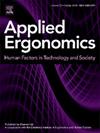Passive arm-support and back-support exoskeletons have distinct phase-dependent effects on physical demands during cart pushing and pulling: An exploratory study
IF 3.1
2区 工程技术
Q2 ENGINEERING, INDUSTRIAL
引用次数: 0
Abstract
Arm-support exoskeletons (ASEs) and back-support exoskeletons (BSEs) can be effective in reducing physical demands during various occupational tasks, yet evidence of their effects in pushing and pulling tasks remains limited. We examined the effects of using a passive ASE and a BSE on task completion time, shoulder and trunk kinematics, and muscle activity in the shoulder and back while pushing and pulling a moderately loaded (100 kg) cart. Forty volunteers (24 M and 16 F) completed the study. Using the BSE substantially reduced thoracic and lumbar erector spinae muscle activity for males, especially during the initial and ending phases of pushing (by up to ∼31.4 %) and pulling (by up to ∼25.4 %) compared to the No Device (ND) condition. In contrast, using the ASE showed no significant benefits, with females experiencing an increase in anterior deltoid muscle activity (by up to ∼46.3 %) compared to ND. Findings from this study help to understand the effects of BSEs and ASEs in pushing and pulling tasks and support the development of more versatile exoskeletons.
被动臂支撑和背支撑外骨骼在推车和拉车过程中对身体需求有明显的相位依赖效应:一项探索性研究。
手臂支撑外骨骼(ASE)和背部支撑外骨骼(BSE)可以有效减少各种职业任务中的体力需求,但它们在推拉任务中的效果证据仍然有限。我们研究了使用被动式 ASE 和 BSE 对任务完成时间、肩部和躯干运动学以及推拉中等负荷(100 千克)推车时肩部和背部肌肉活动的影响。40 名志愿者(24 名男性和 16 名女性)完成了这项研究。与无装置(ND)条件相比,使用 BSE 大大减少了男性胸椎和腰椎竖脊肌的活动,尤其是在推车的初始和结束阶段(减少达 31.4%)和拉车的初始和结束阶段(减少达 25.4%)。相比之下,使用 ASE 没有明显的益处,与 ND 相比,女性三角肌前部活动增加(最多增加 46.3%)。这项研究的结果有助于了解 BSE 和 ASE 在推拉任务中的效果,并支持开发更多功能的外骨骼。
本文章由计算机程序翻译,如有差异,请以英文原文为准。
求助全文
约1分钟内获得全文
求助全文
来源期刊

Applied Ergonomics
工程技术-工程:工业
CiteScore
7.50
自引率
9.40%
发文量
248
审稿时长
53 days
期刊介绍:
Applied Ergonomics is aimed at ergonomists and all those interested in applying ergonomics/human factors in the design, planning and management of technical and social systems at work or leisure. Readership is truly international with subscribers in over 50 countries. Professionals for whom Applied Ergonomics is of interest include: ergonomists, designers, industrial engineers, health and safety specialists, systems engineers, design engineers, organizational psychologists, occupational health specialists and human-computer interaction specialists.
 求助内容:
求助内容: 应助结果提醒方式:
应助结果提醒方式:


